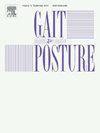Medial meniscus extrusion during squatting is correlated with lower limb kinematics in patients with knee osteoarthritis
IF 2.2
3区 医学
Q3 NEUROSCIENCES
引用次数: 0
Abstract
Background
Increased medial meniscal extrusion (MME) under mechanical stress is a risk factor associated with progression of knee osteoarthritis (OA). Patients with knee OA often have unique features of abnormal kinematics during squatting, which might induce joint loading and increased MME; however, the detailed relationships involved remains unknown.
Research question
In this study, we investigated the effects of knee kinematics on increased MME during squatting in patients with knee OA.
Methods
Sixteen patients with symptomatic knee OA (mean age 56.31 ± 11.46 years) performed squatting in a laboratory setting. Three-dimensional motion analysis was collected focusing on tibial internal rotation, femoral posterior translation. MME dynamics were assessed using ultrasonography, and increases in MME on the waveform of the MME were calculated as the difference in MME between the two points of maximum and initial minimum flexion of the knee joint during squatting.
Results
The waveform and peak of MME were in line with the tibial internal rotation. A significant positive correlation was found between the increase in MME and tibial internal rotation (r = 0.663, p = 0.007), but not the femoral posterior translation.
Significance
Greater tibial internal rotation was correlated with increased MME during squatting in patients with knee OA. These findings contribute to the understanding of the mechanical pathophysiology of knee OA.
膝骨关节炎患者下蹲时内侧半月板挤压与下肢运动学相关
背景:机械应力下增加的内侧半月板挤压(MME)是与膝骨关节炎(OA)进展相关的危险因素。膝关节OA患者通常具有下蹲时运动异常的独特特征,这可能导致关节负荷和MME增加;然而,其中的详细关系仍然未知。研究问题:在这项研究中,我们研究了膝关节运动学对膝关节OA患者下蹲时MME增加的影响。方法16例有症状的膝关节OA患者(平均年龄56.31 ± 11.46岁)在实验室环境下进行蹲坐。三维运动分析集中在胫骨内旋,股骨后平移。使用超声评估MME动态,并计算下蹲时膝关节最大屈曲点和初始最小屈曲点之间MME的差异,从而计算MME对MME波形的增加。结果MME的波形和峰值与胫骨内旋一致。MME的增加与胫骨内旋有显著正相关(r = 0.663,p = 0.007),但与股骨后旋无显著正相关。意义:膝关节OA患者下蹲时,胫骨内旋增大与MME增加相关。这些发现有助于理解膝关节OA的机械病理生理学。
本文章由计算机程序翻译,如有差异,请以英文原文为准。
求助全文
约1分钟内获得全文
求助全文
来源期刊

Gait & posture
医学-神经科学
CiteScore
4.70
自引率
12.50%
发文量
616
审稿时长
6 months
期刊介绍:
Gait & Posture is a vehicle for the publication of up-to-date basic and clinical research on all aspects of locomotion and balance.
The topics covered include: Techniques for the measurement of gait and posture, and the standardization of results presentation; Studies of normal and pathological gait; Treatment of gait and postural abnormalities; Biomechanical and theoretical approaches to gait and posture; Mathematical models of joint and muscle mechanics; Neurological and musculoskeletal function in gait and posture; The evolution of upright posture and bipedal locomotion; Adaptations of carrying loads, walking on uneven surfaces, climbing stairs etc; spinal biomechanics only if they are directly related to gait and/or posture and are of general interest to our readers; The effect of aging and development on gait and posture; Psychological and cultural aspects of gait; Patient education.
 求助内容:
求助内容: 应助结果提醒方式:
应助结果提醒方式:


